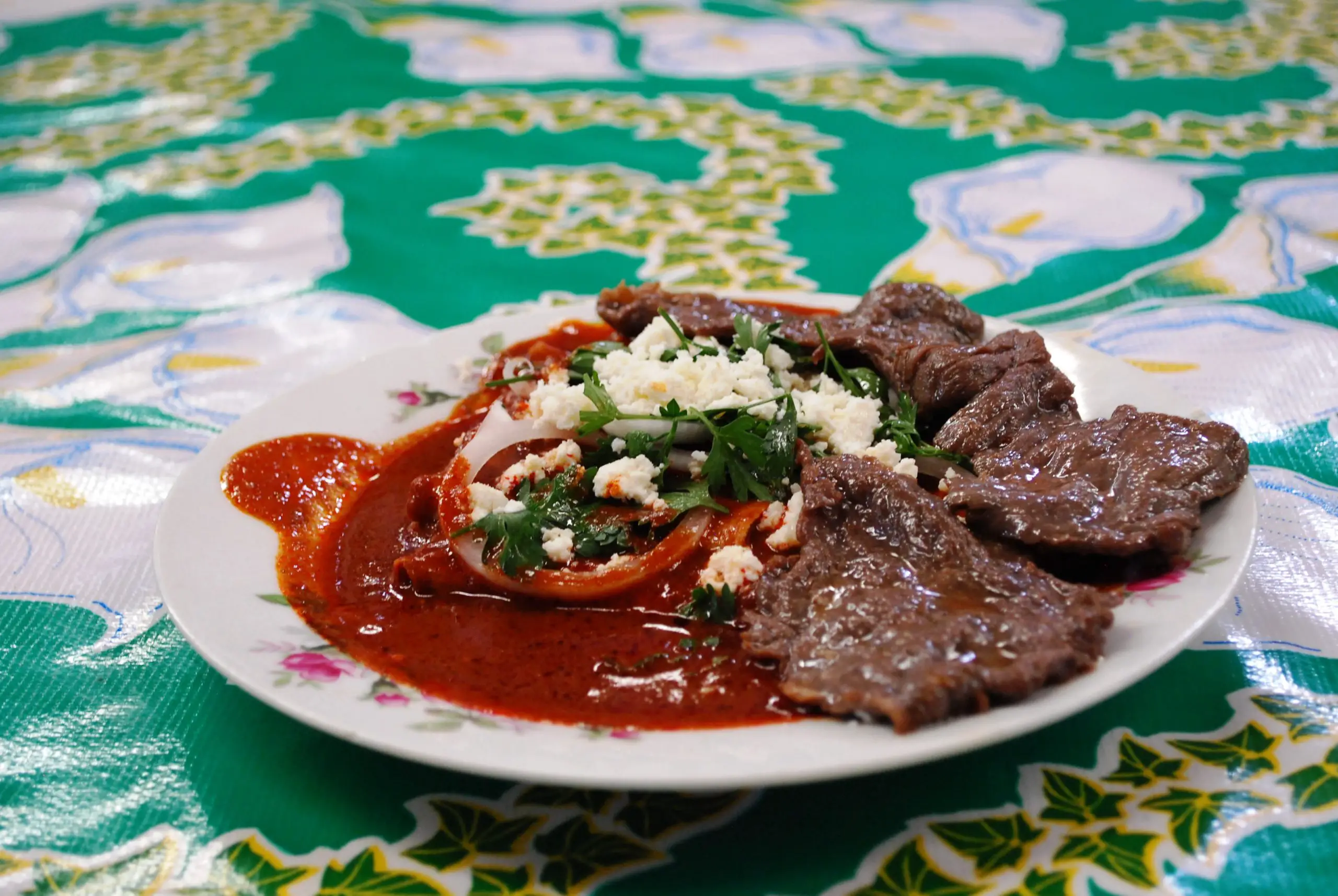Even well-traveled tourists who have years of experience ordering food in restaurants throughout Latin America, including Mexico, may find it a little different getting what they want in a market or restaurant in Oaxaca. It’s not that Oaxacans are so provincial that their palates lack exacting gastronomic sophistication, or that we in Oaxaca don’t know the different between a sandwich on a bun (torta in Oaxaca), and a piece of cake (torta in other parts of Latin America). Food and meal terminology can vary from country to country, and indeed from state to state.
Here’s an explanation of some common culinary terms, essentials when ordering meat (carne) in Oaxaca, whether at high end restaurants, middle-of-the-road lunchtime haunts for tourists and locals, comedors featuring a comida corrida, the markets, the city’s plethora of street stands, or roadside eateries throughout Oaxaca’s central valleys.
One might ask why the need for a glossary of food terms when visiting a popular tourist destination in Mexico. Many restaurants in Oaxaca do not have bilingual menus or staff, especially when one ventures away from the restaurants noted in the usual tourist guides, and into the markets. True enough, those eateries popular with foreign tourists do cater to English speaking clientele; but there’s much to be said for venturing off the beaten track, and sampling food in the smaller comedors, restaurants, and in the markets where Oaxacans eat. All meat plates are served with at minimum a side of corn tortillas, except of course those with tortillas already incorporated into the dish such as tacos and tlayudas.
Meat Dishes in Markets & Restaurants in Oaxaca and its Central Valleys
- Cecina is thinly sliced, grilled or fried pork with a dusting of chili, usually quite tender. It’s generally not very hot, so sampling should entice even those whose intestinal tracts cannot tolerate spicy foods.
- Tasajo is beef, also thinly sliced and cooked just like cecina. It’s usually seasoned with just salt. Tasajo does not tend to be quite as tender as cecina, probably because in modern times virtually any cut of beef is used to prepare tasajo.
- Alambre is strips of meat, usually tasajo, grilled with onion and green pepper (but not exclusively), served with melted quesillo (Oaxacan string cheese) on top. Restaurants serving “authentic” alambre use a better, more tender cut of beef than tasajo.
- Chorizo is Mexican sausage, once again prepared like tasajo and cecina, though sometimes served link, and other times outside the casing. Chorizo is made with minced pork (sometimes with beef as well, and at times using chicken for the more health conscious) and fairly spicy dried chili peppers which have been ground at a local mill. When served as huevos con chorizo it consists of scrambled eggs with fried chorizo mixed in. As choriqueso it’s simply a mixture of fried chorizo and melted quesillo.
- Barbacoa can be misleading, since the meat is not prepared on a grill or barbecue. It’s usually goat or sheep (at fiestas it’s sometimes beef) prepared in an in-ground oven, stewed and often served with its juices, often alongside a mushy hominy-style corn known as zagueza. But when when the menu refers to barbacoa de pollo, it’s chicken prepared with a tomato-based sauce, the distinctive flavor coming from avocado leaf.
- A parrillada is a medley of meats, vegetables and cheese, often partially cooked in the kitchen and then brought to the table, still on the hibachi, where grilling continues.
- A parrilla simple signifies a grill, as in a North American style charcoal barbecue; hence pollo a la parrilla would be chicken grilled over charcoal or firewood, while pollo rostisado usually signifies chicken prepared on a commercial spit as commonly encountered throughout the US and Canada. A parrilla de gas is a propane barbecue.
- Costillas are ribs, arrachera is grilled skirt steak, a chuleta is a pork chop, and albondigas are meat balls.
- Tampiqueña is a better cut of beef, usually grilled filet, traditionally served with enchiladas, beans and torillas. When one orders this dish, nothing more should be needed to provide a full, satisfying meal. The name derives from the fact that tampiqueña originated in Tampico.
- Fajitas are usually strips of pork, chicken or beef, fried with a combination of onion, tomato and chile, accompanied by tortillas and often white rice. This is not a traditional Oaxacan plate, though it’s becoming increasingly popular, especially catering to the tourist trade, á la Tex-Mex. The plate originated from a desire to use up the small strips of chicken which are alongside the breast. Usually the tortillas served on the side are flour tortillas.
- A tlayuda is an oversized tortilla from the comal or grill, with a bit of aciento (seasoned pork fat) and refried bean paste, topped with optional cheese, sliced tomato, avocado and shredded lettuce. It’s served folded or open face. Meat (chorizo, cecina or tasajo) is often added; on the open face version it’s served on top, in strips, and when folded the meat is either inside or served apart.
- Taco stands usually serve soft tacos with most of the above cuts and classes of meat, but the most common is al pastor – pork seen outside on a pit, from which a staff member cuts thin slices and adds a piece of pineapple, and chopped onion and cilantro.
Other Main Courses with Meat Accompaniments Served in Markets & Restaurants in Oaxaca
Tlayudas and tacos should arguably be categorized differently than the other dishes noted above. However, because of the tradition of serving tlayudas and tacos with meat, one can consider them meat plates. There are in fact other main courses which include meats such as enchiladas, but one tends to consider such meals tortilla-based and not meat plates.

It’s not a matter of where, but when. Time is precious and my time spent living and experience the cultures of this world is what I lust for. This is why I created this website, to share true, genuine experiences and not just typical touristy info. Travel, the love of coffee, and food!
